War and Peace: The Belfast Batteries
by Tom Seymour
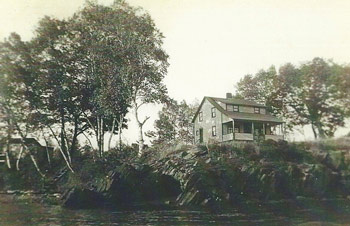
The Brenda Ahlberg cottage, at the east side battery in the 1950s. The battery was located about 3 miles east of downtown Belfast at the end of East Side Battery Lane. Photo courtesy Belfast Historical Society.
Confederate raiders stalking merchant ships up and down the Maine coast, coupled with the raid in Portland Harbor by Confederate forces, caused great consternation. The result was the U.S. military authorized the construction of coastal defenses in a number of Maine towns.
Belfast, a small city on the inner recess of Belfast Harbor, was the recipient of two batteries. Batteries were not true forts in any sense of the word but rather, were protected sites for artillery, the big guns that would, if needed, prevent enemy vessels from entering the harbor. Confederate defenses were often supplemented with gun batteries, but these were separate from the actual forts. In the early years of the war, Union forces feared Confederate “masked batteries.” Most of these were imagined rather than real.
Seeing the need for protecting Belfast, the shire town of Waldo County, from raiding Confederates, the U.S. Army sent Captain Thomas L. Casey to Belfast to select sites for two batteries of artillery. Captain Casey chose land owned by Erastus D. Freeman for the west side battery and a plot of land on the east side of the harbor, opposite Steele’s Ledge.
Neither parcel was ever used for any military purpose until 1863, when the batteries were constructed. The site on the east side was simply called, “The Battery” and the site on the west side was called, “Little River Battery,” due to its close proximity to that part of Penobscot Bay where Little River enters.
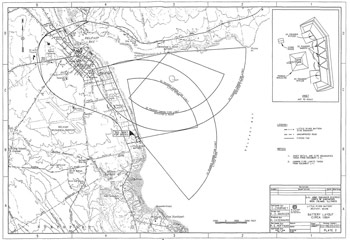
Location and gun ranges of West Battery, 2 miles south of the city, and East Battery 3 miles east of the city on the Searsport Rd.
A description of the Little River Battery comes down to us from a letter written by enlisted man Joel M. Gleason, a cook, stationed there. Gleason, writing home, said: “Perhaps you would like a description of my present place of abode, it is situated across a neck of the Belfast Bay (about three miles by the road, but not over one mile from the city which is in sight).
“There are two batteries one on the east side of the bay opposite the city, which is the one I sleep in. The other is on the same side as the city. The Batteries are just alike in all respects. Each one has three, thirty-two-pound guns and two twenty-four-pound rifled guns.”
The batteries remained active until just after Confederate General Robert E. Lee’s surrender to Ulysses S. Grant at Appomattox Court House on April 9, 1865. In time, troops were discharged, military supplies moved to other sites and the big guns removed to Fort Knox in Prospect.
Seamless Transformation
Then on May 4, 1889, Erastus D. Freeman sold the land that had hosted the Little River Battery to George Johnson, who developed the place as a residential area, primarily geared to summer cottages. This was at a time when people from urban areas of the northeast began visiting Maine each summer in order to enjoy its clear water, crisp air and abundant natural resources. Some chose the sporting life and spent their summers in remote, northern sporting lodges. But others opted for the more comfortable and easygoing setting offered by places such as the Battery.
The Battery (Little River Battery) became such a popular vacation site that soon, out-of-state cottage owners began arriving in spring and not returning home until summer’s end. The summer communities of Bar Harbor and others on Maine’s Mt. Desert Island were contemporaries of the summer community at the Battery.
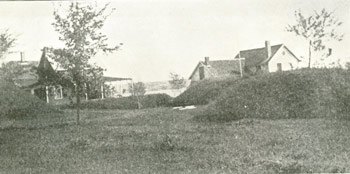
Little River Battery, Belfast. Earthworks in the foreground which protected cannons from ship-board cannon on Penobscot Bay in the background. The houses were not built until after the Civil War ended in the spring of 1865. Photo courtesy of Belfast Historical Society.
Visitors had several ways to get to the Battery. The Eastern Steamship Company made daily Boston-to-Belfast trips and Boston & Maine Railroad and Maine Central Railroad visited Belfast each day except for Sunday. Upon arriving in Belfast, Public carriages and eventually, automobiles were available for the two-mile trip from town to Little River Battery.
In time, some of the summer cottages at The Battery more closely resembled year-round houses than seasonal dwellings. The summer folks were not in any way roughing it and probably had more comfortable accommodations than many of the local residents.
Typical of cottages at the battery were elaborate front porches. Decorated with ornamental plants and supplied with wicker chairs and lounges, these porches were meeting places where people sat in the cool shade and chatted with passing neighbors.
Parties and even lavish clambakes were part and parcel of battery life. Belfast Bay was (and remains, although the flats are currently closed) a prime location for soft-shelled clams and clambakes were the common thread that brought communities together.
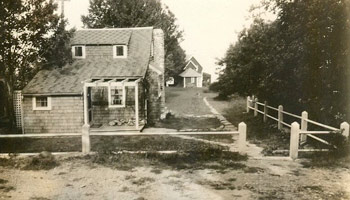
Little River Battery, Belfast. Earthworks in the foreground which protected cannons from ship-board cannon on Penobscot Bay in the background. The houses were not built until after the Civil War ended in the spring of 1865. Photo courtesy of Belfast Historical Society.
At one point in the early years, Battery residents became clannish, posting signs that read, “Private way” and “No Autos Allowed.” The ban on automobiles was eventually found impractical and was rescinded. Likewise, visitors eventually were allowed to stroll, or drive, down the Battery Road.
Today, small summer colonies appear up and down the coast of Maine. But in the late 19th century, the Belfast Battery was one of only a few such communities.
It’s easy to imagine how tranquil and peaceful life was in those Halcyon days, when horse and buggy was the main mode of transportation and the long, hazy days of summer were spent swimming along the rocky shore or on a shady porch sipping iced tea.
Today, the Battery not only serves as a summer retreat for part-time residents, several cottages are occupied year-round.
West Battery
The West Battery, however, did not become a Mecca for people “from away,” but all the same made the transformation from a military installation to a residential area. Currently, a privately owned residence sits on the site of the West Battery.
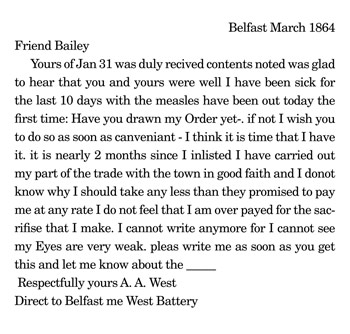
Why the West Battery didn’t follow suit and make the transition to a full-fledged summer colony remains unclear. In fact, nothing exists now that even suggests that here, during the Civil War, was a garrisoned battery of powerful guns whose sole purpose was to protect the City of Belfast from attack by armed Confederates.
Even passing by on the water does not necessarily disclose the location of the West Battery. Someone knowing exactly where to look may succeed in getting a glance at the base of the earthworks, but without a prior knowledge the West Battery remains pretty much out of sight and out of mind. The author has attempted to locate the West Battery from the water but every attempt was met with failure.
It is said, however, that the remains of the West Battery are in a far better state of preservation than those of the Little River Battery. But unless something unforeseen occurs, the West Battery will no doubt remain shrouded in the mists of history for many years to come.
As for the Little River Battery, the glory days of the Victorian Era are long gone, but the atmosphere of a laid-back summer colony remains. Here, the commercialization of a laid-back summer colony has not happened and life at the Battery pretty closely resembles how it was just after George Johnson created one of Maine’s oldest summer communities. And that’s a good thing.
